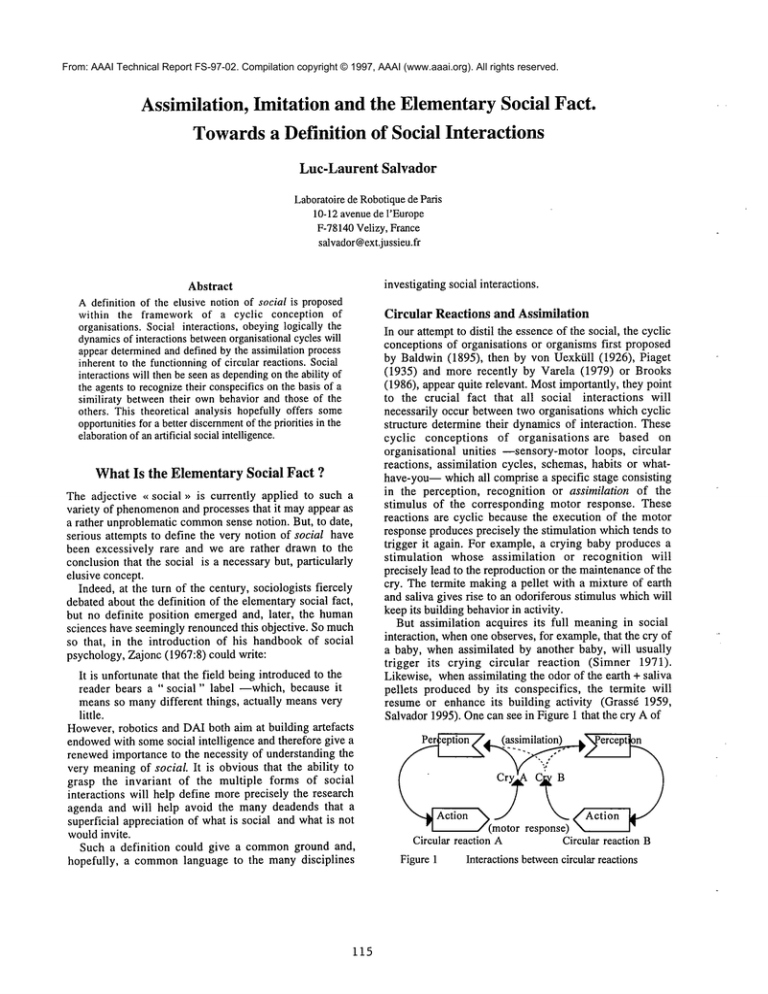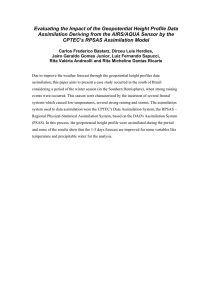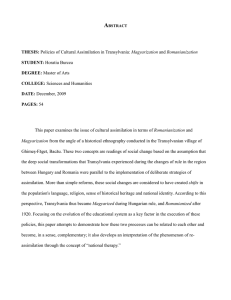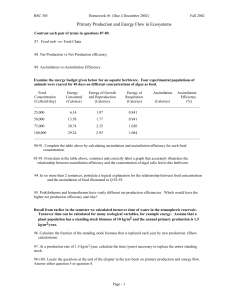
From: AAAI Technical Report FS-97-02. Compilation copyright © 1997, AAAI (www.aaai.org). All rights reserved.
Assimilation, Imitation and the ElementarySocial Fact.
Towardsa Definition of Social Interactions
Luc-Laurent Salvador
Laboratoire de Robotiquede Paris
10-12 avenue de l’Europe
F-78140Velizy, France
salvador @ext.jussieu.fr
investigating social interactions.
Abstract
A definition of the elusive notion of social is proposed
within the framework of a cyclic conception of
organisations. Social interactions, obeyinglogically the
dynamicsof interactions betweenorganisational cycles will
appear determinedand defined by the assimilation process
inherent to the functionning of circular reactions. Social
interactions will then be seen as dependingon the ability of
the agents to recognizetheir conspecifics on the basis of a
similiraty between their own behavior and those of the
others. This theoretical analysis hopefully offers some
opportunitiesfor a better discernmentof the priorities in the
elaborationof an artificial social intelligence.
Circular
WhatIs the Elementary Social Fact ?
The adjective << social >> is currently applied to such a
variety of phenomenonand processes that it may appear as
a rather unproblematic commonsense notion. But, to date,
serious attempts to define the very notion of social have
been excessively rare and we are rather drawn to the
conclusion that the social is a necessary but, particularly
elusive concept.
Indeed, at the turn of the century, sociologists fiercely
debated about the definition of the elementary social fact,
but no definite position emerged and, later, the human
sciences have seemingly renounced this objective. So much
so that, in the introduction of his handbook of social
psychology, Zajonc (1967:8) could write:
It is unfortunate that the field being introduced to the
reader bears a " social " label --which, because it
means so many different things, actually means very
little.
However, robotics and DAIboth aim at building artefacts
endowedwith some social intelligence and therefore give a
renewed importance to the necessity of understanding the
very meaning of social. It is obvious that the ability to
grasp the invariant of the multiple forms of social
interactions will help define more precisely the research
agenda and will help avoid the many deadends that a
superficial appreciation of what is social and what is not
would invite.
Such a definition
could give a common ground and,
hopefully, a commonlanguage to the many disciplines
115
Reactions
and Assimilation
In our attempt to distil the essence of the social, the cyclic
conceptions of organisations or organisms first proposed
by Baldwin (1895), then by von Uexktill (1926), Piaget
(1935) and more recently by Varela (1979) or Brooks
(1986), appear quite relevant. Most importantly, they point
to the crucial fact that all social interactions
will
necessarily occur between two organisations which cyclic
structure determine their dynamics of interaction. These
cyclic conceptions
of organisations
are based on
organisational unities --sensory-motor loops, circular
reactions, assimilation cycles, schemas, habits or whathave-you-- which all comprise a specific stage consisting
in the perception, recognition or assimilation of the
stimulus of the corresponding motor response. These
reactions are cyclic because the execution of the motor
response produces precisely the stimulation which tends to
trigger it again. For example, a crying baby produces a
stimulation
whose assimilation
or recognition
will
precisely lead to the reproduction or the maintenance of the
cry. The termite making a pellet with a mixture of earth
and saliva gives rise to an odoriferous stimulus which will
keep its building behavior in activity.
But assimilation acquires its full meaning in social
interaction, whenone observes, for example, that the cry of
a baby, when assimilated by another baby, will usually
trigger its crying circular reaction (Simner 1971).
Likewise, when assimilating the odor of the earth + saliva
pellets produced by its conspecifics, the termite will
resume or enhance its building activity (Grass6 1959,
Salvador 1995). Onecan see in Figure 1 that the cry A of
Circular reaction A
Figure 1
Circular reaction B
Interactions betweencircular reactions
the circular reaction A has been << recognized >> by the
circular reaction B, being assimilated to the cry B usually
produced. The circular reaction B is consequently
triggered, and therefore producesa cry, similar to the first
one, whichis then re-producedor imitated.
As it is only stressing the invariant dynamics of
interaction betweenbehavioralcycles, no matter their level
of complexity, the very samefigure wouldfit any other
interactions between circular reactions reciprocally
assimilating their productions. It could represent the
interaction dynamicsof, for example,the building behavior
of termites, the collective photoluminescence
of fireflies
(Buck and Buck1978), the chorus of cicadas (Williams
and Smith 1991) and, finally, the whole spectrum of
collective behavior, from simple gregarism to scientific
fashions (Salvador1996).
worldinto at least twoclasses: <<others like me~>and
<< everything else >> is a necessary condition for
intelligent collective behavior.
Myposition is specific only in the sense that assimilationis
here rooted in the circular reaction mechanismwhose
heuristic value will nowbe tentatively underlined.
Consequences
There are manyreasons whyit is heuristic to consider
social interactions as dependingon the ability of the agents
to recognizetheir conspecifics on the basis of a similarity
between their ownbehavior and shape and those of the
others:
1) this conception will help to draw the line between
those simulations or realizations of collective behavior
amongartificial agents which are really investigating
social interactions and those whose programmation or
conceptiontricks result in a serious trivialization of the
matter. For example, when a robot learn by radio
broadcastingwith its workstationthat the obstacle actually
detected by IR sensors is another robot (Mataric 1993),
has absolutely no needfor assimilating the characteristics
of the other to its own. The problem of assimilation is
completely bypassed.
2) In the samevein, a robot whichis directly informedof
the behaviors of its conspecifics by radio broadcasting of
symbolic information is freed of the necessity of an
assimilation of their behavioral expression(Parker 1993).
Therefore, the social interaction is extremelypoor because
an immensepart of meaningis missing. An assimilation
restricted to the symboliclevel can makesense, of course
(cf. Turing’s imitation game)but in order to obtain
satisfying ecological validity, the symbolic level has
probably to emerge from a coupling with the sensorymotor one, where the three fundamental aspects of the
psychologicaldynamics---cognition, conation and affect-remainunited.
3) Let us supposea population of robots whosemembers
emit a <~ species specific >>light or IR signal perceivedby
the other membersbut not by the emitter. In such a case,
there is indeed assimilation or pattern matchingbetween
the anticipation of the signal and the perceivedsignal itself.
But being unable to perceive its ownsignal, the robot does
not genuinely assimilate the others to himself. This keylock mechanism allows no <~ projection r>, i.e. no
representation of the other on the basis of the selfknowledge
inherent to the circular reaction.
4) This isolation is avoided by the circular reaction
mechanismthanks to the permanent transaction between
self and others resulting fromthe assimilation process and
often expressed by imitation. For example,the babyunable
to see her ownmimics--and therefore deprivedof a visual
circular reaction concerningher face-- can, nonetheless,
assimilate and imitate the mimics expressed by an adult
face. This is to be explained by the existence of a
representation of the face built on the sensory-motorloops
of the kinesthetic modality. The baby loops on herself via
The Elementary Social Fact
In such a framework, mycontention is that social
interactions can be defined a minimaas instanciating an
assimilation process of one agent by another. One should
say, moreprecisely, that an agent is in a social interaction
as far as s/he is assimilating,at least partially, the patternof
stimuli emitted by the entity with whichs/he interacts,
whetherthis assimilation is justified or not, whetherit
belongs or not to a more specific behavior (attraction,
agression,fleeing, etc...).
Therefore,an artificial ant whichperceivesthe other ants
as merephysical obstacles disturbing its wandering,is not
in a genuine social situation wheninteracting with them.
Onthe other hand, whendetecting and recognizingthe trail
of pheromone
left by its conspecifics, a natural ant is in a
genuinesocial situation, evenif alone, since it assimilates
this substanceto the one it usually produces. A goodproof
of it lies in the fact that the ant imitates: after assimilating
the pheromone,
it will indeed followthe trail, i.e., it will
reproducethe spatial exploration behavior first exhibited
by its conspecifics.
The close connection between social interaction and
imitation (in a generic sense) comesas no surprise. It is
mechanical consequence of the cyclic structure of
behavior in which assimilation leads to a reproduction of
the stimulation. Thus, one can understand that Tarde’s
mottohas been<<society is imitation >>(1903:87)as well
the fact, underlinedby Strumand Latour (1987:799)that:
Fromthe different languages, the historical genealogy
of the world << social >~ is construed as following
someone, then enrolling and allying and, lastly,
having somethingin common.
(italics are mine)
This conception of the elementary social fact as the
assimilation of one agent by another is congruent with
several approachesbelonging to the fields of sociology,
psychology,ethologyor evolution theory. In robotics too,
several workshave maderather implicit reference to this
idea which has been, however, clearly expressed by
Dantenhahn(1995) or Mataric (1993:434):
Theability to categorize the perceptible objects in the
116
the kinesthetic modality, and this kernel of bodyschema
allows an intermodal matching, namely, a visual
assimilation, whichin turn, leads to a reproductionof the
mimics. (Meltzoff and Moore1994).
5) Now,concerning someof the fundamental questions
raised in this workshop,I wouldfirst like to suggest that
social intelligence, understoodas an abilility and a state of
adaptation to its social environment,is necessarily rooted
in the assimilation process. Since a social behaviorhas any
chanceto be adapted only whenbased on a representation
of the other. And such a representation is built by
assimilation since an agent has no other basis to understand
anotheragent than its ownschemasor circular reactions.
6) Thus, concerning
the interactions
and
communications
betweenhumansand artefacts, it is highly
probable that humans, because of the richness of their
schemarepertoire, will always be able to assimilate the
artefacts to themselves,evenexcessively. This assimilation
which is nothing but empathy, will probably have to be
educated because, quite opposite to the innocuousempathy
for a bat or a tree, the assimilationof an artefact has to be
adapted in order to yield correct anticipations of their
behaviors.
7) Onthe contrary, in the near future, artefacts will
probably showpoor understanding of the humancondition.
Their limited schemarepertoire will only permit simple
assimilations, at best, equivalent to those of animals. But
this is not a problemas far as we knowexactly what to
expect from them.
8) The quality of social interactions between humans
and artefacts will obviously dependon the ability of the
artefact to assimilate humansalong the cognitive, conative
and affective dimensions altogether. For example, the
hunters and their dogs, on account of their reciprocal
assimilation, operate the collective action of hunting while
in a relation of sharedcognition(representationof space, of
the prey), shared conation(sameobjective of capture of the
prey) and shared emotion (tension then satisfaction
frustration). Of course, such a sharing is not sophisticated
when comparedto the one than between humans, but the
unity between the cognitive, conative and affective
assimilationmakesit real, effective and, as a matterof fact,
fully satisfying. Such a psychological unity of the
assimilation process appears as a necessary condition of a
genuinesocial interaction.
Conclusion
Myattempt, here, has been to expoundhowthe notion of
assimilation which has been used by Piaget to modelthe
cognitive functionningfroman individualist perspective is,
in fact, a cardinal notion in the understandingof social
interactions.It has been shownthat, as far as one has
acknowledged the cyclic character of organisations,
assimilation appears necessarily as the locus of social
interaction. As a consequence,it appears that an agent,
natural or artificial, can only conceiveof anotheragent in
direct proportion to the richness of its behavioral
117
repertoire. This is because an agent can elaborate a
representation of another agent only by assimilating the
pattern of stimuli producedby others to the one produced
by its owncircular reactions. Other-representations will
therefore be mouldedon self-representations. But if two
agents assimilate each other, reciprocal imitation will
probablyensueand therefore, self-representations will also
be mouldedon other-representations.
By assimilating
themselves to their artefacts, humanswill acquire new
understandingof their psychologicalfunctionning.
References
Baldwin, J. M. 1895. Mental development. NewYork.
McMillan.
Buck, J. and Buck, E. 1978. Les lucioles ~ luminescence
synchrone.In Les socigtgs animales, 10-19. Paris : PourLa
Science. (originally publishedin Scientific American1978)
Brooks, R. A. 1986. A robust layered control systemfor
a mobilerobot. IEEEJournal of Robotics and Automation,
RA-2:14-23
Dautenhahn, K. 1995. Getting to know each other-Artificial social intelligence for autonomousrobots.
Robotics at~ AutonomousSystems 16:33-356
Grasst, P. P. 1959. La reconstruction du nid: la thtorie
de la stigmergie. Insectes Sociaux6:41-99
Mataric, M. J. 1993. Designing emergent behavior :
fromlocal interactions to collective intelligence. In J. A.
Meyer, H. L. Roitblat, and S. W. Wilson eds. Front
Animalsto AnimatsII, 2-10. Cambridge,Ma.: MITPress
Meltzoff A. N., and Moore, M. K. 1994. Imitation,
memory, and the representations of persons. Infant
Behavior Development17:83-89
Parker, L. E. 1993. Adaptive action selection for
cooperative agent teams. In J. A. Meyer, H. L. Roitblat,
and S. W. Wilsoneds. FromAnimals to Animats II, 2-10.
Cambridge,Ma.: MITPress
Piaget, J. 1936. La naissance de l’intelligence chez
l’enfant. Neuchfitel, Switzerland: Delachaux&Niestlt.
Salvador, L.-L. 1995. Swarmintelligence, collective
action and imitation. In Proceedingsof the First European
Conferenceon Cognitive Science, 267-275.Paris : INRIA.
Salvador, L.-L. 1996 Imitation and attribution of
causality : the mimeticgenesis of self the mimetic genesis
of reality (in french). Ph.D.diss., Lab. of psychopathology,
Paris V Univ.
Strum, S. S., and Latour, B. 1987Redefiningthe social
link: from baboonsto humans.Social Science Information
26(4):783-802
UexkiJll, J. von (1926) Theoretical biology. London:
Kegan,Paul, Trench, Tubner.
Varela, F. J. 1979. Principles of biological autonomy.
Amsterdam: North Holland.
Simner, M. L. 1971. Newborn’sresponse to the cry of
another infant. DevelopmentalPsychology5:136-150
Zajonc, R. B. 1966. Social psychology: an experimental
approach. Belmont: Wadsworth.





